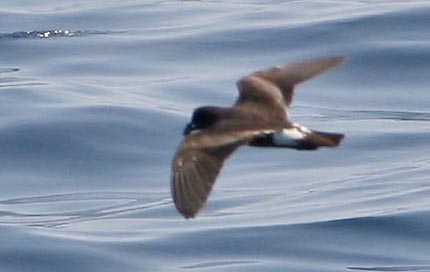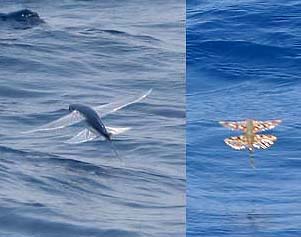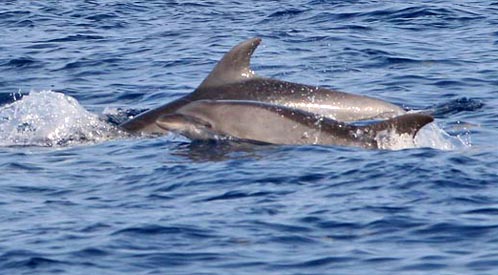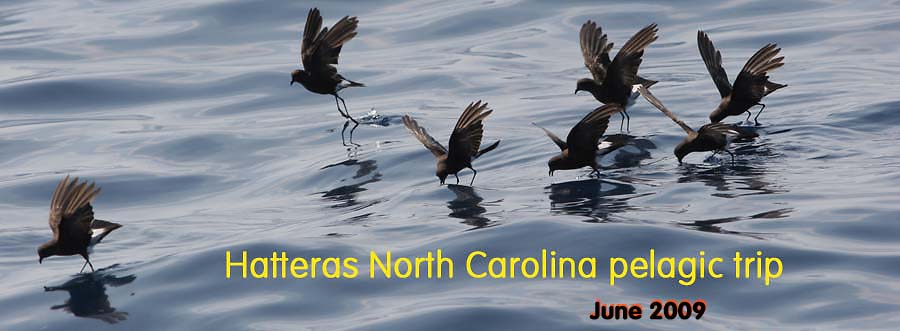
a web page by Don Roberson |
The warm waters of the Gulf Stream host patchy smatterings of birds, but this deep water avifauna is unique. The most widespread bird is Wilson's Storm-Petrel, which are readily attracted to slicks of fish oil or shark liver (above). The trips were aboard the Stormy Petrel II, owned and skippered by Brian Patteson (below left). Each trip was co-led by experienced East Coast birders: on 14 June it was Bob Fogg, Ned Brinkley, and Kate Sutherland (L to R, below right). |
||
|
||
On both trips I was pleasantly surprised to find that my old friend Dave DeSante, founder and controller of the Institute for Bird Populations, was aboard (below left). Like me, he was taking advantage of a visit to Washington, D.C., as an excuse to add an Atlantic seabirding weekend [Dave was attending an ornithological workshop; I would meet Rita later for a vacation visit to historic sites in the Virginia/Washington D.C. area]. The weather was warm and pleasant; seas not too bad (a bit bouncy on 13 June); and although we did not encounter any great rarities, the 'usual suspects' were around.
|
||
 |
||
Variation in Cory's Shearwater (below) was also evident, and is related to specific island populations. The most common were "Atlantic" Cory's Shearwater C. d. borealis: a huge, hulking shearwater with white underwings but all-dark remiges (below left). A very few were slightly smaller birds with more buoyant flight and (often) a scaly back, and a different underwing pattern. The most prominent example was one that followed the boat on 13 June (below right) with prominent white 'fingers' in the underwings, including the outermost primaries. This is the Mediterranean breeding "Scopoli's Shearwater" C. d. diomedea, sometimes considered a separate species; identification is discussed in Gutiérrez (1998) and Howell & Patteson (2008a). |
||
|
||
Also present each day were a few Greater Shearwater (below left). On 14 June, we came upon two Bridled Terns sitting on a bit of flotsam; they flushed upon close approach (below right) and passed over the boat at close range (directly below). These were non-breeding, first-summer individuals. |
||
|
||
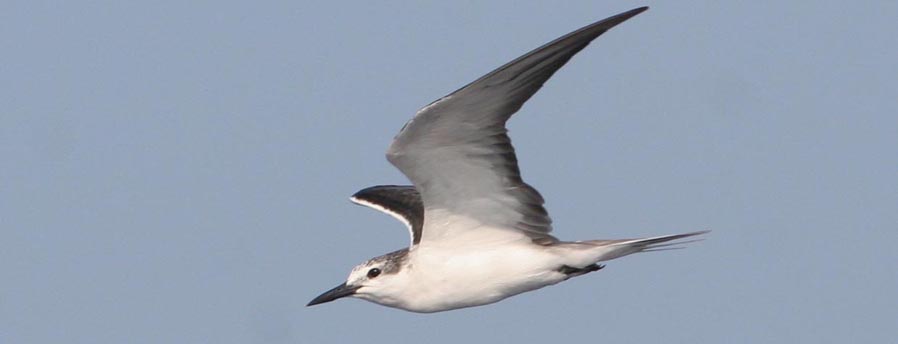 |
||
| The ever-present Wilson's Storm-Petrels were interesting. Most were in active wing molt, retaining the outer four primaries but growing in new inner primaries (see below). Note the long dangling legs and yellow webs to the feet as they "walk" across the water. In the close-up with tail spread (below right) you can see the white inner webs of the outer rectrices, something present on Wilson's Storm-Petrel but few other species (e.g., Leach's, for example, has all-dark rectrices (Murphy 1936). Band-rumped Storm-Petrel — or at least those specimens that I have examined — has entirely white bases to the outer rectrices. This in-hand character is rarely mentioned in i.d. discussions. I wonder if it has been checked against the various populations that may prove to be separate species? (see below). The photo below these close-ups is of a swarm of Wilson's pattering across a slick laid out by Kate Sutherland. | ||
|
||
 |
||
| Each trip we had a handful of Band-rumped Storm-Petrel among the hundred-plus Wilson's. They are most readily picked up by their larger size, longer wing shape, and different flight style — deeper wing beats than Wilson's and some gliding, but not 'bounding' nighthawk flight which is characteristic of Leach's (we had one of those on 14 June). Wilson's (below left) has a broader white 'rump' (actually the uppertail coverts and tips to some rump feathers; Murphy 1936), a square tail (not slightly notched as on Band-rumped, below right), and long legs that extend well beyond the tail (short legs of Band-rumped do not extent beyond tail). Note also differences in wing shape and even bill size. The Band-rumpeds (except one) were all in a different state of wing molt than the Wilson's. Compare the Wilson's (below left) with this Band-rumped (below right): Wilson's has retained four outer primaries and is molting in new inners, while Band-rumped at this date has retained only two old outer primaries and is farther along in growing in new inner primaries. | ||
|
||
The discussion of molt timing brings us to a new topic: recent genetic and breeding phenology evidence suggests that there may be four (or more?) distinctive populations of Band-rumped Storm-Petrel in the tropical Atlantic Ocean (Bolton et al. 2008, summarized in Robb et al. 2008, Bennett 2009). Further, populations in the Pacific are even more distinctive (Friesen et al. 2007, Bolton 2007). It is possible that birds currently lumped as "Band-rumped Storm-Petrel" Oceanodroma castro should be assigned to somewhere between two (Atlantic vs. Pacific) to six or more species (four in Atlantic, two more in Pacific). In the Atlantic there are summer breeding birds on the Canary Is., Madeiran Is., and Selvagens (nominate castro) and summer breeders in the Azores (already proposed as O. monteiroi Monteiro's Storm-petrel; Bolton et al. 2008), and then there are winter breeding populations on the Azores, Canaries, and Madeiran islands (not yet formally named but informally proposed as "Grant's Storm-Petrel" in Robb et al. 2008), and a year-round breeder on the Cape Verde Is. (jabejabe; can breed much of year but most nest in winter; Robb et al. 2008). In addition, there is now evidence of summer and winter breeding populations on St. Helena I. in the south Atlantic (Bennett et al. 2009); there are also summer and winter breeders in the Galapagos (Friesen et al. 2007). |
||
In this photo (left) you can clearly see that wing molt status: outer two primaries are old and worn brown, but retain their full length, while the growing inner primaries are much fresher, blackish in color, and are not yet full length. You can also see that this is a 'big-billed' storm-petrel and has a clean while 'rump' band. The tail is short, only slightly indented in the center, and the legs do not reach the end of the tail. This shape shows also in the backlit photo of one of these "Grant's" type (below). The white rump band is comparatively narrow. In addition, these are quite large Band-rumpeds — decidedly larger than Wilson's and most easily picked out with the naked eye by that size. |
||
 |
||
Whether the AOU and other official committees will accept these splits is uncertain. The genetic differences are greatest between Atlantic and Pacific populations, and less dramatic within the Atlantic populations. It has long been known that Leach's Storm-Petrel has winter and summer breeding populations on Guadalupe I. in the tropical Pacific (Ainley 1980, 1983) and yet Leach's has not yet been split. Wilson (2009) comments on other obstacles to taxonomic revisions, and Shirihai (2009) cast some doubt on molt timing in "Grant's." So this is all up in the air at the moment, and may continue to be for years. Yet it is clear enough that there are different 'types' of Band-rumps off North Carolina. On 14 June Brian Patteson picked up what he called a "split-rumped" Band-rumped (below). It was not as large as the other Band-rumps we'd seen; it had a less deep-stroking flight; and it had completed wing molt. [The bird had picked up a bit of food and is holding it, thus the bill looks large.] It was clearly a Band-rumped — short and only slightly notched tail (not a long, forked tail like Leach's), the legs that did not reach end of tail, and the carpal bar was not well marked — but there was a dark 'line' down the center of the rump (below right) recalling Leach's. Yet the pattern is not like Leach's, because the rump band is as broad in the center as anywhere, and in Kate Sutherland's photo of this bird, one can see that the 'line' is actually a series of spots. In other words, the central uppertail covert feathers have dark tips, forming a line of spots that "split" the rump. In addition, the white rump band is wider than typical on "Grant's" types and the tail is almost square-tipped. |
||
|
||
Which Band-rumped type is this? Perhaps it is the summer breeding nominate castro type, from the Canary and Madeiran Is., possibly called Madeiran Storm-Petrel? In the photos published by Robb et al. (2008), only the Madeiran Storm-Petrel shows spots in the white rump band. [Another photo from off North Carolina shows a similar bird with an apparent line down the center of the rump, but in the book it is left unidentified.] If so, why isn't it on the breeding grounds? Or is it a non-breeding individual from those populations? Or could this be a winter breeding bird from the Cape Verde Is., sometimes considered a separate species O. jabejabe, as suggested by Robb et al. (2008). Would such birds have completed wing molt? No one really knows yet, but the lack of wing molt may suggest this is a 'hot season' (=summer) breeder, like nominate castro. Kate said this was just the 3rd such individual seen by them this spring. Clearly the taxonomy and identification of Atlantic white-rumped storm-petrels is more complex than we had thought! |
||
Any day offshore can be fascinating. When there were no birds, there could be Offshore Bottlenosed Dolphin (below left), or a distant party of Goose-beaked Whale, or many flying fish of 2 or more species (right & below right). And to top it off, one night in Hatteras the day concluded with a fantastic double rainbow (bottom of page)! |
||
|
||
Literature cited:
|
||
|
 In mid-June 2009 I joined back-to-back pelagic trips off Hatteras, North Carolina, with
In mid-June 2009 I joined back-to-back pelagic trips off Hatteras, North Carolina, with 
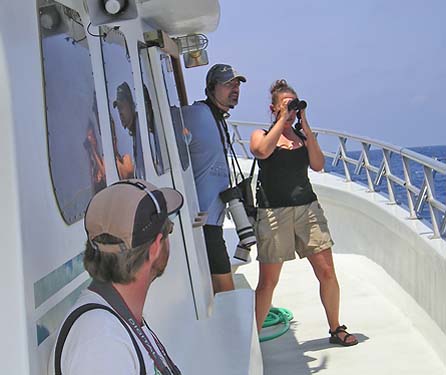
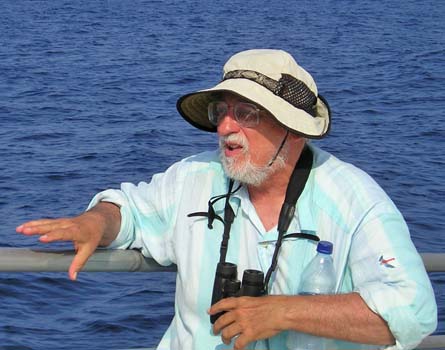
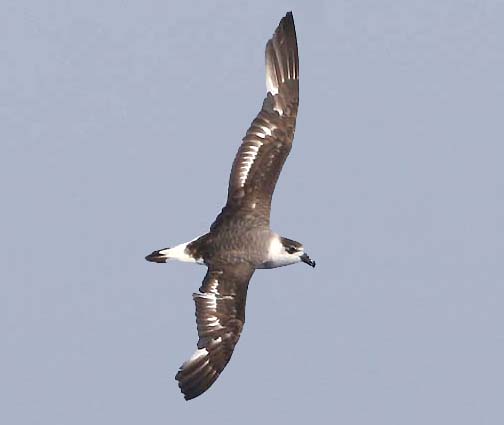 Perhaps the most desired offshore birds are Pterodroma petrels. The regular species is Black-capped Petrel
(above & left). All our birds were in heavy post-breeding molt.
"Light morph" types predominated, such as the one at left with broad
while collar, but there were some "dark" or "intermediate" types
(above) with dingy collars. This variation has recently been quantified
(Howell & Patteson 2008b) but it is not known whether it is related
to specific island populations.
Perhaps the most desired offshore birds are Pterodroma petrels. The regular species is Black-capped Petrel
(above & left). All our birds were in heavy post-breeding molt.
"Light morph" types predominated, such as the one at left with broad
while collar, but there were some "dark" or "intermediate" types
(above) with dingy collars. This variation has recently been quantified
(Howell & Patteson 2008b) but it is not known whether it is related
to specific island populations. 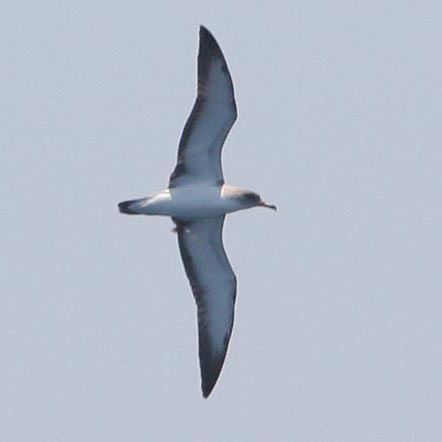
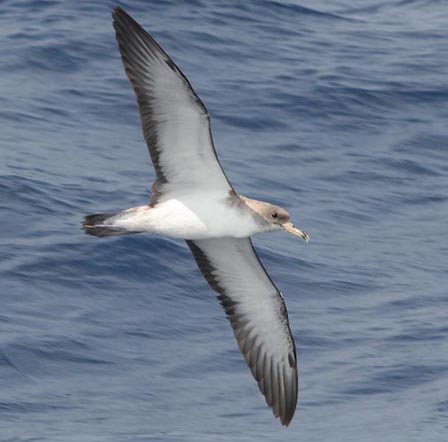
 Another reasonable common species was Audubon's Shearwater
(right). It breeds in the Caribbean and ranges northward in the Gulf
Stream. Atlantic birds are of the nominate race. In the Pacific, the
populations in the Galapagos Islands have recently been split as
Galapagos Shearwater Puffinus subalaris.
Another reasonable common species was Audubon's Shearwater
(right). It breeds in the Caribbean and ranges northward in the Gulf
Stream. Atlantic birds are of the nominate race. In the Pacific, the
populations in the Galapagos Islands have recently been split as
Galapagos Shearwater Puffinus subalaris. 


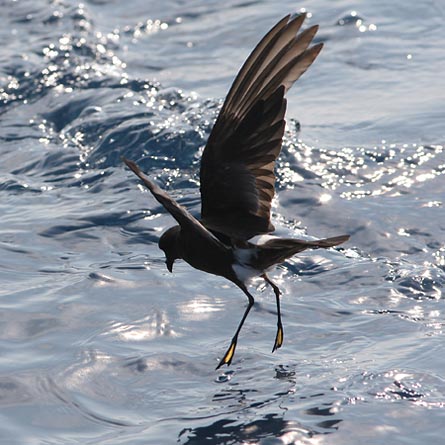
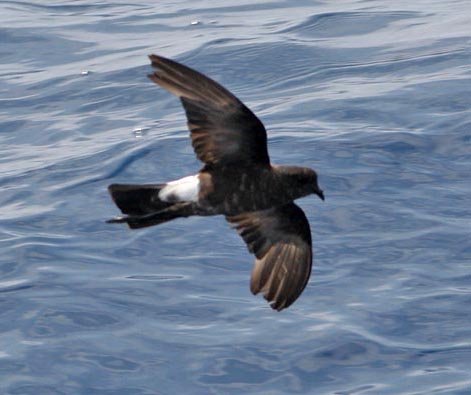
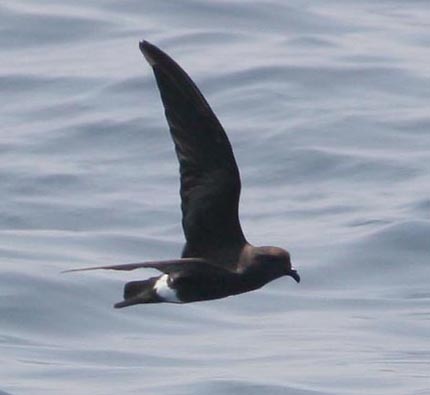
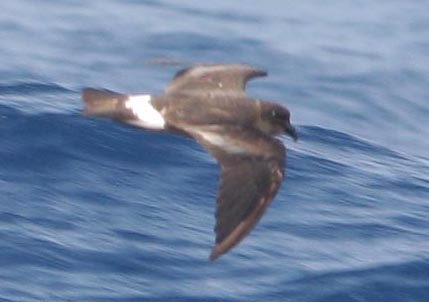 According
to Brian Patteson and the other trip leaders, the majority of
Band-rumped-type storm-petrels off North Carolina in May-June should be
the unnamed "Grant's" type, showing post-breeding
molt following the winter breeding season (August-March) on the Azores
and Canary Islands, etc. We assumed that all the Band-rumps seen on my
trips were "Grant's" (except one; see more discussion below).
According
to Brian Patteson and the other trip leaders, the majority of
Band-rumped-type storm-petrels off North Carolina in May-June should be
the unnamed "Grant's" type, showing post-breeding
molt following the winter breeding season (August-March) on the Azores
and Canary Islands, etc. We assumed that all the Band-rumps seen on my
trips were "Grant's" (except one; see more discussion below). 
